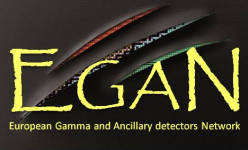Speaker
Natalia Cieplicka
(Institute of Nuclear Physics, Polish Academy of Sciences, Krakow)
Description
The 206Bi nucleus is a one-proton-particle, three-neutron-hole system with respect to the doubly magic 208Pb core. Its low-energy structure arises from 1p-3h couplings involving 1h9/2, 2f7/2, and 1i13/2 proton particles, and 3p1/2, 2f5/2, 3p3/2 and 1i13/2 neutron holes. The 206Bi ground state, with spin-parity Jπ=6+, is of πh9/2νf5/2-1 character, with the isomeric (T1/2=7.7 μs) Jπ=4+ member of the πh9/2νp1/2-1 multiplet lying only 60 keV above it. At higher excitation energies, two other isomeric states have been identified in an earlier study with the 205Tl(α,nγ) reaction[1]. These are the 10- state at 1045 keV with T1/2=0.89 ms and an assigned πh9/2νi13/2-1 configuration, and the 15+ excitation at 3147 keV, with a 15.6 ns half-life of πh9/2ν(p1/2)-1(i13/2)-2 character. The highest yrast states known thus far in 206Bi, i.e., 17+ and 18+ levels at 3604 and 4305 keV have been located in the 205Tl(α,nγ) work as well. An experiment performed recently at Argonne National Laboratory, USA, in which gamma rays emitted during reactions induced by a 76Ge beam on a thick 208Pb target were measured with the Gammasphere array, showed that deep-inelastic processes populate relatively high-spin states in nuclei located "north-west" of 208Pb. One of the intense products was 206Bi. We analyzed the spectra of delayed gamma rays (emitted between beam bursts separated by ca. 412 ns) by requiring coincidences with the known 206Bi yrast transitions. A series of higher-lying gamma rays, deexciting two previously unknown 206Bi isomers, have been found. Inspection of the double gates set on these newly discovered transitions, allowed us to extend the 206Bi level scheme up to an isomeric level with the half-life >1 μs located at approximately 10 MeV. For the lower isomer, a half-life of 155(15) ns was established . With the help of the in-beam gamma-ray angular distributions and the extracted conversion coefficients we obtained information on multipolarities of some strong transitions. We have been able to propose spin and parity assignments for the new states up to 23+, based on their decay pattern and on comparisons with the shell model calculations. For higher lying states, spin and parity assignments were done on the basis of the extracted transition multipolarities. As the result, the spin of Jπ=32+ was proposed for the higher isomer what makes it one of the longest-lifetime isomers known with spin above 30 ħ. The yrast excitations located at energies up to approx. 7 MeV can be described in terms of the 1p-3h couplings. Higher lying yrast states, including the two new isomers, must involve neutron excitations across the N=126 shell gap.
Primary author
Natalia Cieplicka
(Institute of Nuclear Physics, Polish Academy of Sciences, Krakow)
Co-authors
Bogdan Fornal
(Institute of Nuclear Physics, Polish Academy of Sciences, Krakow)
Christopher J. Chiara
(Physics Division, Argonne National Laboratory, Argonne, IL, USA; Department of Chemistry and Biochemistry, University of Maryland, College Park, MD, USA)
Jacek Wrzesinski
(Institute of Nuclear Physics, Polish Academy of Sciences, Krakow)
Karl H. Maier
(Institute of Nuclear Physics, Polish Academy of Sciences, Krakow)
Michael P. Carpenter
(Physics Division, Argonne National Laboratory, Argonne, IL, USA)
Rafal Broda
(Institute of Nuclear Physics, Polish Academy of Sciences, Krakow)
Robert V. F. Janssens
(Physics Division, Argonne National Laboratory, Argonne, IL, USA)
Shaofei Zhu
(Physics Division, Argonne National Laboratory, Argonne, IL, USA)
Tomasz Pawlat
(Institute of Nuclear Physics, Polish Academy of Sciences, Krakow)
William B. Walters
(Department of Chemistry and Biochemistry, University of Maryland, College Park, MD, USA)
Wojciech Krolas
(Institute of Nuclear Physics, Polish Academy of Sciences, Krakow)

